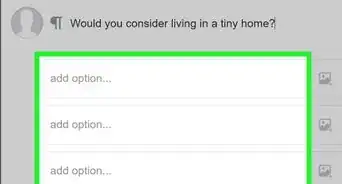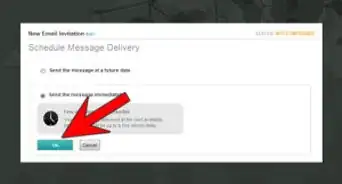This article was co-authored by Matthew Snipp, PhD. C. Matthew Snipp is the Burnet C. and Mildred Finley Wohlford Professor of Humanities and Sciences in the Department of Sociology at Stanford University. He is also the Director for the Institute for Research in the Social Science’s Secure Data Center. He has been a Research Fellow at the U.S. Bureau of the Census and a Fellow at the Center for Advanced Study in the Behavioral Sciences. He has published 3 books and over 70 articles and book chapters on demography, economic development, poverty and unemployment. He is also currently serving on the National Institute of Child Health and Development’s Population Science Subcommittee. He holds a Ph.D. in Sociology from the University of Wisconsin—Madison.
There are 9 references cited in this article, which can be found at the bottom of the page.
wikiHow marks an article as reader-approved once it receives enough positive feedback. This article received 13 testimonials and 100% of readers who voted found it helpful, earning it our reader-approved status.
This article has been viewed 169,855 times.
Businesses, educators, government officials and everyday folk have an interest in collecting information. A survey is just that: a way to collect information about and learn from your respondents. Although surveys might appear easy to design at first blush, there's more than meets the eye. See Step 1 for more information on how to produce the best, most useful surveys to make your life easier.
Steps
Designing the Survey
-
1Establish the goals for the survey. Simply put, what do you hope to gain from your survey? The questions you ask all need to point back to this essential idea.[1]
- For example, say that you're an employer and you want to figure out whether your employees are happy. The survey questions you ask, either directly or indirectly, need to address the happiness of your workers. You could ask them directly, "On a scale of 1 to 10, how happy are you at work?" or you could formulate a more indirect question, like "True or False: I wake up every day feeling like my work has a purpose."
- After you've designed all your survey questions, it might be helpful to go through each question and ask yourself how each one is helping you accomplish the goal of the survey. Any question that doesn't give you essential information about your survey objective should be removed.
-
2Spend some time thinking about how you can ensure the most honest answers. If your goal is to figure out whether your employees are happy, you want an honest answer. In fact, with surveys, you always want honest answers. But it can be tough to get an honest answer if your employees feel like they could lose something — respect, standing, etc. — by being honest. Think about whether or not you need to tweak your survey in order to get honest results. With an employee happiness survey, for example, you might want to give respondents the option of completing it anonymously.[2]Advertisement
-
3Decide on the best survey method to collect valuable information with the survey. Some options include telephone surveys, face-to-face interviews, surveys by mail, and Internet questionnaires. Each survey method has advantages and disadvantages, which should be weighed against the budget, available personnel and other considerations.[3]
- In general, face-to-face interviews, although they are costly and time-consuming, deliver the most representative results and finest granularity in responses. On the other hand, online questionnaires sometimes come with significant biases, but they are the easiest and cheapest surveys to administer.
- If you're only going to rely on one form of survey, such as an online questionnaire, consider surveying more people to make up for possible biases.[4] For the cleanest results, you might want to administer several different kinds of surveys.
-
4Think about ensuring accuracy in your survey. A survey that involves one or two respondents will tell you something about each one of the respondents, but it will not provide much accurate information about trends. In order to figure out how many people you should survey, you'll need two pieces of information:[5]
- The size of your population. What population do you want to understand? If you want to understand happiness at your company, your population is the size of your company. If you want to study adoption of condom usage in Uganda, your population is the size of Uganda, or roughly 35 million.
- The certainty that your results are accurate. With survey accuracy, people talk about two ideas: margin of error and confidence interval. Margin of error is the degree of uncertainty you have in the results of your survey. Confidence interval is the degree of certainty you have that the survey samples the population accurately.
-
5Based on your target population and desired accuracy level, select your sample size. Once you've answered the above questions — what population am I targeting? and how accurate do I need to be in my results? — you can start thinking about how many people you'll need to survey in order to get the desired results. In the table below, select your target population on the left, then select your margin of error to estimate how many surveys you'll need. As a general rule, the more surveys you give, the lower your margin of error will be.[6]
| Population | Margin of Error | Confidence Interval | ||||
|---|---|---|---|---|---|---|
| 10% | 5% | 1% | 90% | 95% | 99% | |
| 100 | 50 | 80 | 99 | 74 | 80 | 88 |
| 500 | 81 | 218 | 476 | 176 | 218 | 286 |
| 1,000 | 88 | 278 | 906 | 215 | 278 | 400 |
| 10,000 | 96 | 370 | 4,900 | 264 | 370 | 623 |
| 100,000 | 96 | 383 | 8,763 | 270 | 383 | 660 |
| 1,000,000+ | 97 | 384 | 9,513 | 271 | 384 | 664 |
Asking the Right Questions
-
1Decide whether to use structured, unstructured questions, or a combination of both. How well do you know your respondents? Is the purpose of your survey to gather data on ideas you already know or explore new ideas? If you're gathering data about ideas you already know, you probably want to lean on structured questions. If you're gathering new ideas entirely, you probably want to lean unstructured questions.[8]
-
Structured questions ask a question and then provide answer choices below. An example of a structured question would be:
(1) "What is your favorite online activity?"
(a) Chatting/IM
(b) Social Networking
(c) Knowledge Sharing/Forums
(d) Shopping/Ecommerce -
Unstructured questions remove predetermined answers from the equation. Instead of leading the respondent in a particular direction by giving him or her answers to choose from, unstructured questions encourage the respondent to develop a very personal answer. An example of an unstructured question would be:
(2) "Talk about your first experience stepping into an Apple Store."
Answer:
-
Structured questions ask a question and then provide answer choices below. An example of a structured question would be:
-
2Choose a partially structured question to get a little more granularity but still keep the data analyzable. The downside of a structured question is that it's often not very specific. The downside of an unstructured question is that it's hard to analyze the response and/or put it into a spreadsheet. Enter the partially structured question. The partially structured question softens the downsides of each:[9]
(3) "How would you describe your attitude toward paying for music? Select all that apply."(__) I never pay for music(__) As a rule, I pay for music I listen to(__) I often download music illegally(__) I seldom download music illegally (__) I could be enticed to pay for music if I got more in exchange (__) There is nothing that could entice me to pay for music(__) I feel bad for musicians who are trying to earn a living wage(__) I don't feel bad for musicians who are trying to earn a living wage -
3Ask a "Rating" question. This is a subset of the structured question. It seeks to answer how respondents would rate their experience on a scale. Your scale can be numbered or have a more sophisticated rubric:
(4) "The Brooklyn Zoo is fun for both children and adults."
(a) Strongly Disagree
(b) Disagree
(c) Agree
(d) Strongly Agree[10] -
4Ask a "Ranking" question to get an ordered list of preferences. A Ranking question does a better job than a Rating question at get people's opinions about a given topic. An example of a Ranking question might be something like:
(5) "In the space provided below, rank the brands you trust the most, with '1' being the most trustworthy and '5' being the least trustworthy."
(a) ___ McDonald's
(b) ___ Google
(c) ___ Walmart
(d) ___ Costco
(e) ___ Apple[11] -
5When developing structured questions, include catch-all phrases at the end of your answer set. It can be helpful to include options like "Other," "None of the Above," etc. at the end of your answer set. These options usually make the responses more accurate. Without a catch-all phrase, a respondent who doesn't find the answer that applies to them is forced to choose an inaccurate answer in order to complete the question.[12]
Distributing the Survey
-
1Find a way to distribute your survey. Once you've decided what type(s) of survey(s) you'll be using, you want to give thought to how you'll give all your respondents the questions.[13]
- The internet has made online questionnaires very simple to design and send. Services like Google Forms, SurveyMonkey, and others offer surveys that are easy to make and free.
- If you are going to distribute telephone surveys or want to conduct face-to-face surveys, expect to shell out money. The data that you gather is usually more representative, but it comes at a price. You can often hire professional contractors to conduct the survey for you.
-
2Make the return of the information as easy as possible. Including postage on a mail survey makes the return of the survey much more likely. Distributing the survey at inconvenient times will discourage participation. A group kept after work or at the end of a long day may give you information slanted by a fatigue or resentment.
-
3Analyze the results of the survey. If your data didn't come to you bundled in a single location, now might be the time to gather it. Excel is a great tool for just this. Use excel to run formulas, create charts, and analyze the data. In short, figure out what the respondents had to say.[14]
-
4Develop your learnings and implement them. Now ask yourself why. Why are your employees unhappy, for example? The answer might have be embedded inside some of your answers. If it's not, you might be able to create a new survey to help you answer those burning questions. Then, when you've figured out the why — my employees are unhappy because they aren't getting enough perks — you can implement and iterate on your new strategy.
Expert Q&A
-
QuestionHow can I ensure people return the surveys I give them?
 Matthew Snipp, PhDC. Matthew Snipp is the Burnet C. and Mildred Finley Wohlford Professor of Humanities and Sciences in the Department of Sociology at Stanford University. He is also the Director for the Institute for Research in the Social Science’s Secure Data Center. He has been a Research Fellow at the U.S. Bureau of the Census and a Fellow at the Center for Advanced Study in the Behavioral Sciences. He has published 3 books and over 70 articles and book chapters on demography, economic development, poverty and unemployment. He is also currently serving on the National Institute of Child Health and Development’s Population Science Subcommittee. He holds a Ph.D. in Sociology from the University of Wisconsin—Madison.
Matthew Snipp, PhDC. Matthew Snipp is the Burnet C. and Mildred Finley Wohlford Professor of Humanities and Sciences in the Department of Sociology at Stanford University. He is also the Director for the Institute for Research in the Social Science’s Secure Data Center. He has been a Research Fellow at the U.S. Bureau of the Census and a Fellow at the Center for Advanced Study in the Behavioral Sciences. He has published 3 books and over 70 articles and book chapters on demography, economic development, poverty and unemployment. He is also currently serving on the National Institute of Child Health and Development’s Population Science Subcommittee. He holds a Ph.D. in Sociology from the University of Wisconsin—Madison.
Research Fellow, U.S. Bureau of the Census This is a huge problem for researchers, actually. You can offer them an incentive (some institutions and companies will even offer cash rewards), but there isn't a ton you can do outside of that.
This is a huge problem for researchers, actually. You can offer them an incentive (some institutions and companies will even offer cash rewards), but there isn't a ton you can do outside of that. -
QuestionCan you create an online survey using Google Forms?
 Matthew Snipp, PhDC. Matthew Snipp is the Burnet C. and Mildred Finley Wohlford Professor of Humanities and Sciences in the Department of Sociology at Stanford University. He is also the Director for the Institute for Research in the Social Science’s Secure Data Center. He has been a Research Fellow at the U.S. Bureau of the Census and a Fellow at the Center for Advanced Study in the Behavioral Sciences. He has published 3 books and over 70 articles and book chapters on demography, economic development, poverty and unemployment. He is also currently serving on the National Institute of Child Health and Development’s Population Science Subcommittee. He holds a Ph.D. in Sociology from the University of Wisconsin—Madison.
Matthew Snipp, PhDC. Matthew Snipp is the Burnet C. and Mildred Finley Wohlford Professor of Humanities and Sciences in the Department of Sociology at Stanford University. He is also the Director for the Institute for Research in the Social Science’s Secure Data Center. He has been a Research Fellow at the U.S. Bureau of the Census and a Fellow at the Center for Advanced Study in the Behavioral Sciences. He has published 3 books and over 70 articles and book chapters on demography, economic development, poverty and unemployment. He is also currently serving on the National Institute of Child Health and Development’s Population Science Subcommittee. He holds a Ph.D. in Sociology from the University of Wisconsin—Madison.
Research Fellow, U.S. Bureau of the Census I don't really see what the problem would be with that, although I'd probably use a different website or delivery method depending on the scope of the research, though.
I don't really see what the problem would be with that, although I'd probably use a different website or delivery method depending on the scope of the research, though. -
QuestionHow do I create a survey for students?
 Community AnswerUse Google Forms. Send students the link, and they can fill it out online.
Community AnswerUse Google Forms. Send students the link, and they can fill it out online.
References
- ↑ Matthew Snipp, PhD. Professor & Research Institute Director. Expert Interview. 26 March 2020.
- ↑ https://www.nbrii.com/our-process/validity/
- ↑ http://www.sciencedirect.com/science/article/pii/S2212977413000331
- ↑ Matthew Snipp, PhD. Professor & Research Institute Director. Expert Interview. 26 March 2020.
- ↑ https://www.surveygizmo.com/resources/blog/how-to-improve-your-data-quality-so-you-have-actionable-results/
- ↑ Matthew Snipp, PhD. Professor & Research Institute Director. Expert Interview. 26 March 2020.
- ↑ https://www.surveymonkey.com/mp/sample-size/
- ↑ https://www.sciencebuddies.org/science-fair-projects/references/how-to-design-a-survey
- ↑ https://ir.ucsd.edu/_files/2009-planning-your-survey.pdf
- ↑ https://measuringu.com/rating-scales/
- ↑ https://www.qualtrics.com/blog/rating-or-ranking-choosing-the-best-question-type-for-your-data/
- ↑ https://measuringu.com/rating-scales/
- ↑ Matthew Snipp, PhD. Professor & Research Institute Director. Expert Interview. 26 March 2020.
- ↑ Matthew Snipp, PhD. Professor & Research Institute Director. Expert Interview. 26 March 2020.
About This Article
To create a survey, start by identifying the goal of the survey so you can craft specific questions that help you achieve that goal. You can create questions with multiple choice answers, a rating scale, or the option to write an answer in a provided space. A combination of these question types can also be helpful! To ensure you get the most honest answers, consider allowing the recipients to fill out the survey anonymously. For more tips on the different kinds of questions you can use, read on!









































































